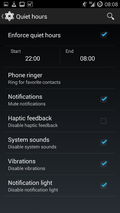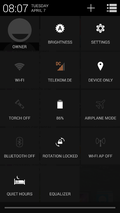Now that 3GPP has officially started working on 5G, the time has come to put lofty ideas and cheap talk into practical specifications. I'm looking forward to this because I still find most ideas that are currently floating around too abstract and unrealistic. But vendors and the NGMN have started publishing whitepapers that give a bit more insight into where we are going. After reading the whitepapers of Ericsson, Nokia and the NGMN on the topic, here's my summary and my own thoughts:
Radio Technology Mix: All whitepapers agree that 5G will not be about a single radio technology vying for dominance but rather a technology mix. Current radio technologies such as LTE(-Advanced) in the cellular domain and Wi-Fi in the home and office domain will be further evolved and are part of the technology mix. New technologies should be specified to grasp the potential offered by using large chunks of so far unused spectrum above 6 GHz for communication over very short distances. Some technologies are already there today, take Wi-Fi 802.11ad as an example.
Virtually Latency Free: The "Tactile Internet" is a new buzzword which means tactile remote control of machines and instantaneous (virtually latency free) feedback. Here's a good description of the concept. Marketing managers are promising round trip delay times of a millisecond in future networks but forget to mention the constraints. But perhaps they have discovered Star Trek like subspace communication? More on this in a future post.
Ultra-Dense Deployments With Ultra-Cheap Radios: As all whitepapers I've read correctly point out, the only way to increase data rates is to shrink cell sizes. This goes hand in hand with using higher frequency bands above 6 GHz. That means that the number of (what we still call) 'base stations' has to grow by orders of magnitude. That in turn means that they have to become ultra-cheap to install, they must configure themselves without human intervention and operate at almost zero cost. Sounds like a nice challenge and perhaps it could be done by turning light bulbs into yocto base stations (nano, femto and other small units are already used…) for this to become a reality? But who's going to pay the extra money to put a transmitter into light bulbs, who's going to 'operate' the light bulb and should such connectivity be controlled or open to everyone? That's not only a technical question but will also require a totally different business model compared to network operators running a cellular network and installing infrastructure without involvement of their customers. Again, the light bulb comes to mind. Light bulbs and power cables that are installed by their owners not only to illuminate a certain area for them but also for others. So in addition to fundamentally new technology and fundamentally new business models it's also a fundamentally new psychological approach to providing connectivity. Perhaps it should be called "light-bulb connectivity"?
Lots of Devices Exchanging Little Data: Today's networks are optimized to handle a limited number of devices that transfer a significant amount of data. In the future there might well be many devices talking to each other or to servers on the network and exchange only very little data and only very infrequently. That means that a new approach is required to reduce the overhead required for devices to signal to the network where they are and that they are still available, perhaps beyond what 3GPP has already specified as part of the 'Machine Type Communication' (MTC) work item.
Local Interaction: Great ideas are floating around on radio technologies that would allow local interaction between devices. An example are cars communicating with each other and exchange information about their location, speed, direction, etc. Sounds like an interesting way to enable cars driving autonomously or to prevent accidents but might break the business model of making money by backhauling data.
Spectrum Licensing Scheme Shake-Up: Some whitepapers also point out that for higher frequencies it might not make a lot of sense to sell spectrum for exclusive use to network operators. After all, range is very limited and not everybody can be in the same place. So license-free or cooperative use might be more appropriate especially if a chunk of spectrum is not used for backhauling but only for local connectivity.
3GPP's Role: All of this makes me wonder a bit how 3GPP fits into the equation? After all it's an industry body where manufacturers and network operators are defining standards. In 5G, however, network operators are probably no longer in control of the 'last centimeter' devices and thus have no business model for that part of 5G. So unlike in 2G, 3G and 4G, 3GPP might not have all the answers and specifications required for 5G?
Summary
So here's my take on the situation: For 5G, everything needs to change and whenever the concept or a part of it is discussed one central question should be asked: Who is going to backhaul the massive amounts of data and how is that done? In 2G, 3G and 4G that question was very simple to answer over the last decades: Network operators are setting up base stations on rooftops and install equipment to backhaul that data over copper cables, fiber or radio. For 5G that simple answer will no longer work due to the massive increase in the number of radios and backhaul links required. Operators will no longer be able to do that on their own as we move from nodes that cover the last mile to nodes that only cover the last centimeters. That means we have to move to a 'lightbulb' model with all that this implies.



